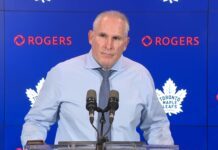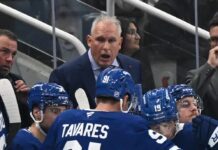As the All-Star break approaches, the Maple Leafs find themselves in a playoff spot, but several quality teams are nipping at their heels. As it stands, it’s tight enough in the standings that, on any given down week, the Leafs could find themselves out of the playoffs altogether.
The uneasiness about the standings is unfamiliar territory for the team and its fan base compared to the past few seasons. Consider their place in the standings on January 25 of the past two seasons compared to this year:
| Season | Points Percentage | League Rank |
|---|---|---|
| 2023-24 | .609 | 11 |
| 2022-23 | .694 | 4 |
| 2021-22 | .697 | Tied for 7 |
This has inspired many conversations about how the Leafs should approach the 2024 trade deadline. Multiple times, Elliotte Friedman has floated the idea of the Leafs thinking about the bigger picture instead of aggressively buying.
Friedman on Sheldon Keefe (TJMS): "The more I think about it the more I would be shocked if anything happened with him in season…. I mean there is always tactical things you can do better, but I think this is bigger than him and I think that's the way they see it too"
— NHL Watcher (@NHL_Watcher) January 19, 2024
Friedman (32TP): "I think Toronto is thinking bigger picture, I don't think this is about this year anymore, I think they're thinking about where they are going. I really wonder if deep down, that as an organization they're saying, we are not good enough to win this year.."
— NHL Watcher (@NHL_Watcher) January 19, 2024
Chris Johnston also suggested he doesn’t believe the Leafs are as all-in as they have been previously, specifically saying that he thinks they will be “careful” with their asset management, although he expects them to make a move or two.
Nick Kypreos and Justin Bourne spoke about it at length, and for what it’s worth, Kypreos was one of the first in the Toronto media to start discussing Nylander’s contract average annual value as starting with 11. I don’t want to misrepresent this segment, though; Bourne clearly said he thinks the team should be buyers and that they are closer to winning the Cup than missing the playoffs altogether. It was partly radio fodder (which is what radio is for!).
That said, there is enough smoke around the possibility of the Leafs selling, or not buying, to warrant a discussion.
The Leafs’ playoff odds
While the current standings territory is a step back for the Leafs from past seasons, some proper perspective is required.
The team’s odds of making the playoffs vary by source, but by and large, they are still very much on track to comfortably qualify for the postseason at this rate. As of January 25, 2024 (before the games that took place at night), Dom at The Athletic calculates their playoff odds at 94 percent, MoneyPuck pegs their chances at 87.6 percent, and Hockey-Reference measures them at 81.9 percent.
It is sometimes easy to forget that the playoffs are not some sort of forgone conclusion after the Leafs made it seven years running. Even though the team hasn’t won anything yet, it shouldn’t be taken for granted.
Look at a team such as the New Jersey Devils, who are very much on the border of missing the playoffs following a first-round win victory last season and heavily buying in the offseason. Dougie Hamilton is now on LTIR and might miss the rest of the regular season, Jack Hughes is going to miss roughly a month, and Michael McLeod — who was in the midst of a strong season — is now on indefinite leave.
The Leafs’ lack of top-five success, coupled with a bad taste in the mouth of the fan base considering their annual playoff appearances and a lack of draft/prospect capital, has led some to wonder if maybe they should treat 2023-24 as a retooling season, sell off their expiring players, and take a bigger/better swing next season.
If, in a month from now, the Leafs are on the outside looking in, that would be one thing. Right now, though, they have every reason to believe they are a playoff team. Every year brings new challenges; the margin between winning and losing is a fine line, and the health of a team’s top players is a big factor. The idea of the GM looking at a season where the Leafs, led by a superstar who could realistically score 70 goals, are well on their way to the playoffs and concluding, “Maybe we aren’t actually that good, so we shouldn’t really do anything,” is somewhere between asinine and malpractice.
It’s all about the right kind of buying
All of the above said, there is a difference between adding to the team and throwing all inhibition to the wind. Therein lies the issue.
The Leafs were aggressive buyers under Kyle Dubas — often rightfully so — but they didn’t come close to winning and the list of high draft picks traded away over the past five years is almost startling to review: By my count, a total of six first-round picks, five second-round picks, seven third round picks, and three fourth-round picks.
Some draft picks were acquired along the way to recoup lost picks (like trading Rasmus Sandin and Kasperi Kapanen for first-round picks), but the team just went through a run of not drafting in the first round in three of five entry drafts. Over the past three drafts, the Leafs selected just 11 players total out of 21 native draft picks.
Not only does it hurt the team’s prospect pipeline, but it also limits the assets at their disposal to acquire help right now. The Leafs already don’t have a second-round pick in any of the upcoming three drafts or a first-round pick in the 2025 draft.
Making it particularly painful is the return on investment in some of these cases. Three-month rentals for Ryan O’Reilly and Nick Foligno cost big packages of draft picks centered around a first-round selection. Not only did the team not go deep in the playoffs, but they were also unable to retain either of them.
On a smaller scale, Dubas traded a pair of third-round picks for Luke Schenn and David Rittich, who also both walked in the offseason.
The other trades that also cost a package of draft/prospect capital are much less discussed but have a common theme: the Jake Muzzin, Mark Giordano, Jack Campbell, and Jake McCabe acquisitions. The difference here is that the Leafs received/are receiving multiple years of service from all of those players.
If anything, this is where Treliving should be looking to spend the valuable assets the organization still possesses. Looking around at the top teams in the league, we will find all sorts of players acquired around the trade deadline who came with term or the team held the player’s rights beyond the season.
The Florida Panthers acquired Sam Bennett and Brandon Montour in 2021, both of whom are critical to the team’s current success.
The Boston Bruins acquired their current de facto 1C in Charlie Coyle ahead of the 2020 trade deadline and their second-best defenseman, Hampus Lindholm, at the 2022 deadline.
When Tampa Bay won back-to-back Cups, they acquired Blake Coleman and Barclay Goodrow — both with term on their deals — before winning both of their championships.
The Avalanche added Artturi Lehkonen before winning their Cup and also acquired pending UFA Josh Manson, who they retained.
Currently, the Oilers look like a powerhouse, and one of their most critical players, Mattias Ekholm, was acquired last deadline with term on his deal.
You could look at Vegas and suggest they didn’t make major moves right before winning their Cup, but this would partly ignore acquiring Ivan Barbashev, who cost a prospect drafted in the first round, played on their top line, and was fifth in team playoff scoring. Beyond Barbashev, look at some of their mainstays: Captain Mark Stone was acquired before the 2019 trade deadline, Jack Eichel was traded for mid-season the year before they won the Cup, and Alec Martinez was acquired via trade in 2019 as well.
You get the point. We can go on and on rifling through teams and finding examples of players who top teams acquired for value or the team paid extra to acquire a quality player on a good deal. There are many examples of top teams acquiring top-of-the-lineup contributors for multiple seasons.
If we look at the Leafs’ current roster, they’ve only traded for three players: Jake McCabe, Conor Timmins, and Mark Giordano. Is the alternative waiting for the Timothy Liljegrens, Nick Robertsons, and Matthew Knies’ of the world to develop while either overpaying or bargain-bin hunting on the free-agent market to fill out the rest of the roster? This would be a poor way to construct a roster around players the organization is paying huge money to try to win right now.
Brad Treliving’s approach to his first trade deadline in Toronto
Hemorrhaging high picks to acquire short-term rentals with no guarantees that the assets remain in the organization beyond a few months is difficult to justify at this point. Buying younger players with term and/or good contracts is a much different proposition and should be the focus of the Leafs.
Treliving briefly discussed the trade deadline approach after signing William Nylander a few weeks ago. The caution in his words became a talking point, but to me, it sounded more like he wouldn’t be pursuing short-term rentals if he could help it.
“I also think you have to be careful on the trade deadline. We will continue to watch our team, but I am not a big believer that you make your team (at the deadline). You have to be careful with that.
Are there tweaks that you’d like to do? Sure. We have X number of assets that we don’t necessarily want to be throwing out the door. Certainly, we are continuing to watch our team. We are continuing to see if there are ways to help it. We will continue to do that up to the deadline.”
My interpretation is that a large part of what Treliving was conveying above is that the team needs to be careful when spending to add — truthfully, it was a line the Leafs crossed on at least two of their deadlines in the recent past by adding a collection of players who barely played.
At the same time, this team is clearly a talented one with some flaws. Tinkering around the edges is likely not going to be enough to help them leap back into the top tier. Their biggest issue is the lack of quality in their top-four defense group, and the reality is that notable help is likely not on the way internally — that’s even if Timothy Liljegren emerges coupled with a nice find in Simon Benoit.
Morgan Rielly is locked in long-term, and Jake McCabe has another year on his deal at just $2 million. Benoit will be an RFA this summer as will Liljegren, while Timmins has another year on a cheap contract.
This isn’t just about the 2023-24 season; it’s about adding a quality defenseman to the group to improve the rosters for years to come with an eye toward building the defense properly.
A defenseman such as Jakob Chychrun is relatively young and has term on his contract (and if Ottawa moves him because it didn’t work out there, it wouldn’t bother me — the organization has been a mess). Noah Hanifin is relatively young and would need to be signed immediately, similar to what the Bruins did with Lindholm (and Treliving, the former Flames GM, should know better than anyone if Hanifin is worth the money). Both are intriguing possibilities.
Older but still quality defensemen like Adam Larsson and Jamie Oleksiak have term, can eat quality minutes, and move the needle on the blue line.
With this category of acquisition, the Leafs would not be mortgaging their future to win now. They would be investing in the future for years to come with Auston Matthews, William Nylander, and Morgan Rielly all locked in already.
A team isn’t going to be built at the deadline, but a GM can certainly add quality and improve the team’s odds. Especially when we’re talking about an odds-on playoff team, it’s imperative to take those opportunities when they’re available.

![Craig Berube on Easton Cowan rejoining the Leafs: “He’s given us some really good games… The [demotion] was just a move made for roster reasons, but he’s back” Craig Berube, Toronto Maple Leafs head coach](https://mapleleafshotstove.com/wp-content/uploads/2025/04/berube-craig-leafs-prac-218x150.jpg)












![John Gruden after the Leafs prospects’ 4-1 win over Montreal: “[Vyacheslav Peksa] looked really comfortable in the net… We wouldn’t have won without him” John Gruden, head coach of the Toronto Marlies](https://mapleleafshotstove.com/wp-content/uploads/2025/09/gruden-post-game-sep-14-218x150.jpg)









![Craig Berube on Easton Cowan rejoining the Leafs: “He’s given us some really good games… The [demotion] was just a move made for roster reasons, but he’s back” Craig Berube, Toronto Maple Leafs head coach](https://mapleleafshotstove.com/wp-content/uploads/2025/04/berube-craig-leafs-prac-324x235.jpg)








